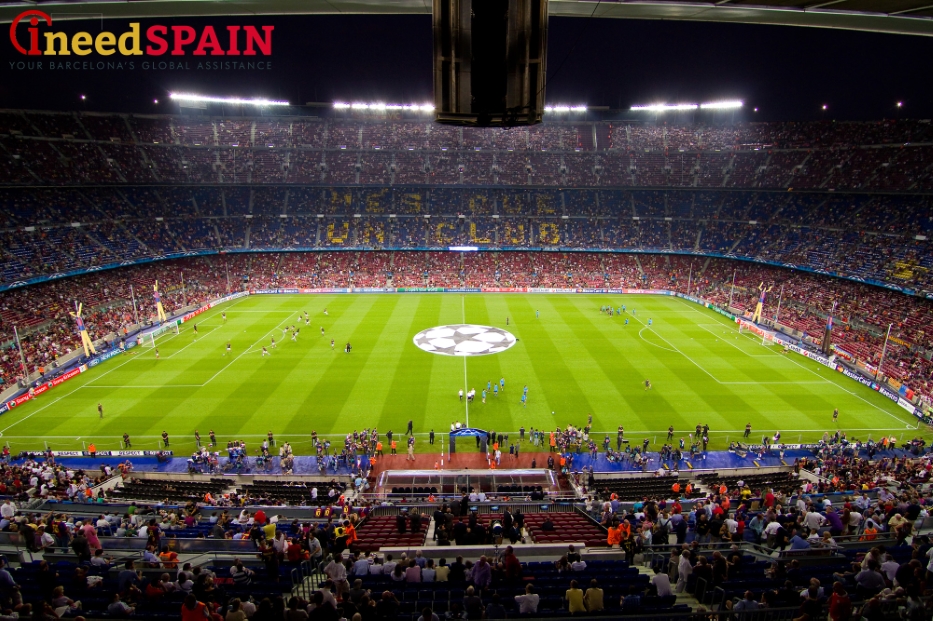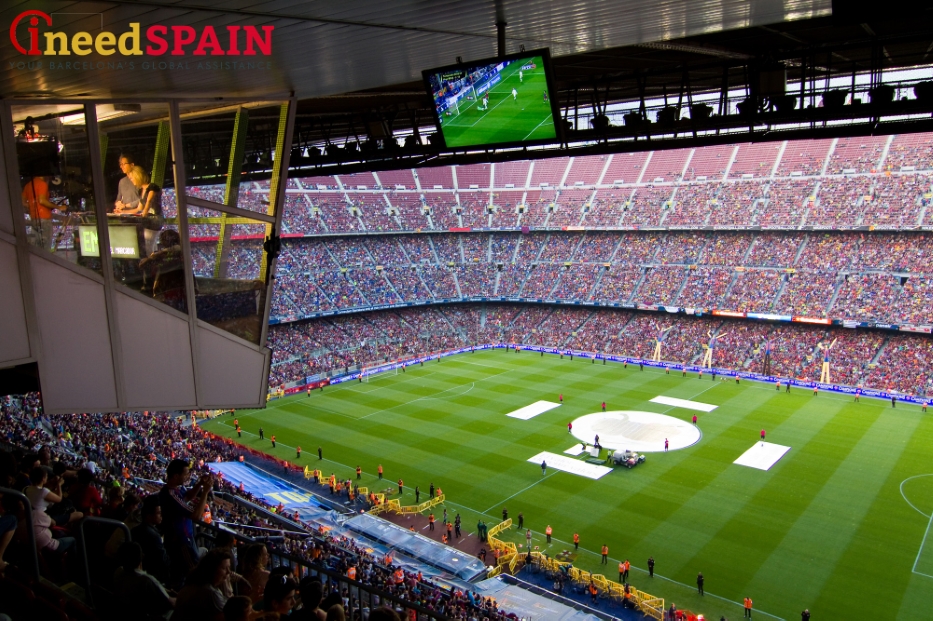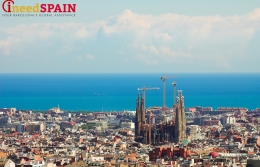
It goes without saying that the formation of FC Barcelona—or “Barça,” as fans more frequently refer to the team—is the story of a tremendous success. In over a century of the club’s history, the team has transferred stadiums three times. This history began in 1909, when the efforts of Barça’s first president, Joan Gamper, resulted in the creation of the first football stadium of Barcelona, known as “Carrer Indústria.” In those times, the seating capacity of 8 thousand spectators was evidence of the vast success of the recently established club. Barça’s popularity was growing, and as early as the beginning of the 1920s, the team took up residence in the new stadium in Les Corts, which was capable of hosting 22,000 viewers. (Only shortly after, following a reconstruction, it could accommodate 60,000 people.) Starting in 1957, the stadium of FC Barcelona, or “Camp Nou,” became the new permanent residence of the Catalan team. Over the years, such stars in world football as Guardiola, Maradona, Ibrahimovic, Rivaldo, and Messi have played on the field in this stadium.
Camp Nou stadium was built according to the project planned by the Catalan architect Francisco Mitjans. The original budget for the construction works was exceeded three times over, and the building process last four years instead of the planned two. The inauguration of the stadium in the fall of 1957 was accompanied by festive celebrations. Moreover, the Barça team played a friendly football match with the Polish football club “Legia,” which ended with a score of 4:2 in favor of the host team.
What does Camp Nou look like today?

- In terms of size, the stadium of FC Barcelona holds second place in the world among fields that are designed exclusively for football (and is inferior only to the Mexican stadium, “Aztec”);
- The stadium capacity is slightly over 90,000 persons;
- The field dimensions are 108 m long and 70 m wide;
- Camp Nou hosts matches between the most prestigious European and world champions. In 1992, the football tournaments of the Olympic Games were held here;
- Since the 1980s, the stadium of FC Barcelona has been used as a stage for musical concerts as well. Over the years, the stadium has hosted performances by Michael Jackson, Freddie Mercury, Julio Iglesias, and U2;
- The stadium of FC Barcelona is the only 5-star stadium in the world (UEFA version).
Barcelona stadium and museum tour

Currently, tourists visiting the stadium of FC Barcelona can take advantage of the excursion called “Barcelona FC Camp Nou Experience,” which includes not only a walk around the stadium, but also access to the museum of FC Barcelona at Camp Nou. The great advantage of this tour is the chance to imagine yourself as an integral part of the team or of the whole football experience and to try out various roles, such as player, coach, commentator, journalist, and even president (with a specially assigned V.I.P. seat). The tour consists of two parts: first is the overview of the stadium (which lasts, on average, about two hours) and second is a visit to the museum of FC Barcelona, which is also located on stadium grounds.
It is worth mentioning that Camp Nou is the most popular landmark among tourists to Barcelona. Every year, thousands of people from all over the world pay a visit to Barça’s local stadium. The stadium of FC Barcelona does not offer guided tours, and the zones available for visiting are marked by yellow railings. Next to the objects of interest, visitors can find placards with explanations inscribed on them. In case you are curious for even more information, it is possible to rent an audio guide at the beginning of the tour.
The Barcelona stadium and museum tour includes:
- A virtual, 3D video as an introduction to the excursion. This takes the form of a bright and creative video-collage featuring fragments of legendary matches played by the football club throughout its history.
- The locker room for guest teams. It is a curious fact that the guests’ locker room is quite modest and very simple in its design and facilities. By contrast, the locker room for the Barça players is much larger and more imposing; it consists of several different spaces, including a pharmacy, SPA, and a conference room. However, access to this locker room is closed to tourists.
- A tiny chapel on the stadium of FC Barcelona. This is a sacred place where players have the opportunity to pray before matches. In the beginning of the 1980s, the chapel was sanctified personally by John Paul II.
- The tunnel through which the football players pass when coming out to the field, the dug-outs, and the coach’s spot. From these positions, the stadium looks more impressive, especially when you imagine that it is filled with spectators.
- Press center and mix zone. After every match, press conferences are organized in a designated space in Camp Nou with the participation of two players to represent the team, while in the mix zone, the journalists do their best to obtain the first brief comments from the football players and coaches.
- Lithography created by Joan Miró, one of the most prominent avant-garde painters of the Spanish XX century, also is available for observation. Next to it, you will find the legendary plate with five stars that was solemnly presented to the stadium in 1999.
- In the museum of FC Barcelona at Camp Nou, visitors get the unique chance to visit the Presidential box and the commentator’s cubicle, which are considered the best viewing points in the whole stadium. Directly in front of you there, you will see the phrase that is written on all the stadium seats, “Mes que un club,” which can be translated from the Catalan as, “More than a club.”
- In addition, the tour program includes a visit to the FC Barcelona museum. In terms of visitors’ rankings, the museum is a landmark inferior only to the Pablo Picasso Museum in Barcelona. The museum of FC Barcelona at Camp Nou consists of three halls. The first hall presents a collection of photos connected with the history of the club and the stadium as well as an interactive touch-pad providing more in-depth information about the club. The second hall hosts an art exposition dedicated to Barça. This is the place where thematic exhibitions related to the life of the club are organized frequently. In the third hall, you can admire the team’s numerous winning cups. Moreover, you are welcome to take a photo with the main trophy, the League of Champions’ Cup, for a fee of 13 euros. Also, the museum at Camp Nou displays Leo Messi’s legendary “golden boots” and even Diego Maradona’s T-shirt.
FC Barcelona museum address:C. d'Aristides Maillol, 12, 08028 Barcelona, Spain. It is possible to reach Camp Nou both by metro (from stations Maria Cristina or Les Corts) and by buses # 7, 15, 43, 67, 68, 74, 75, L12, L50, L60 y L62.
The most convenient option is to buy tickets for the tour on the stadium website a couple of days before your planned visit (and it is crucial to make sure that no match is planned for that day). However, if the online option does not work for you, you can purchase the tickets in person near the stadium’s entrance #9.
If you are not afraid of long lines, you can buy the tickets in the ticket offices of the stadium next to entrance #9 during the working hours: Monday-Saturday: 10:00 - 18:15, Sunday: 10:00 - 14:30.
Museum of FC Barcelona prices:
- 23 euros - adults;
- 17 euros – children under 16 years old;
- Free of charge – children under 6 years old.
INEEDSpain service center will help you to organize your tour or excursion, including tours to the stadium of FC Barcelona. You can book both an individual and group tour. Moreover, INEEDSpain is ready to assist you in such services as choosing schools for new residents, providing consultations on football training, and even selecting a football agent for promising young players.





